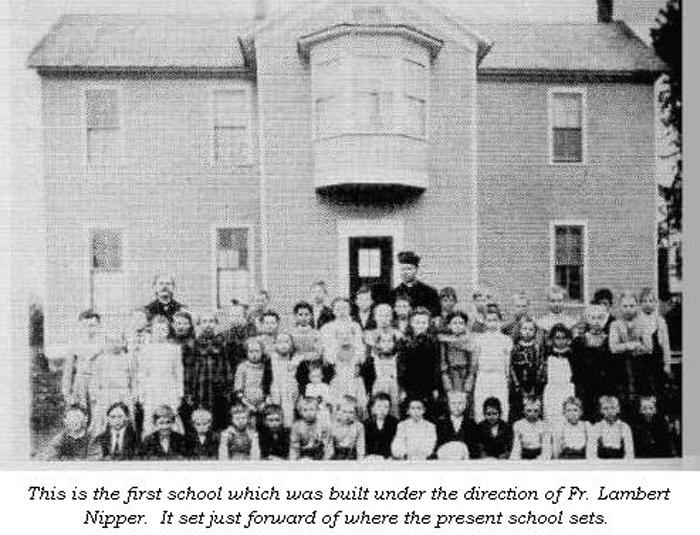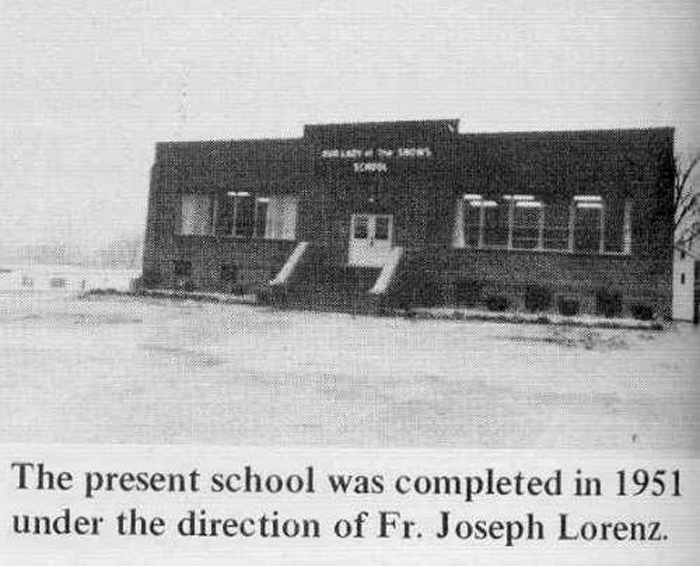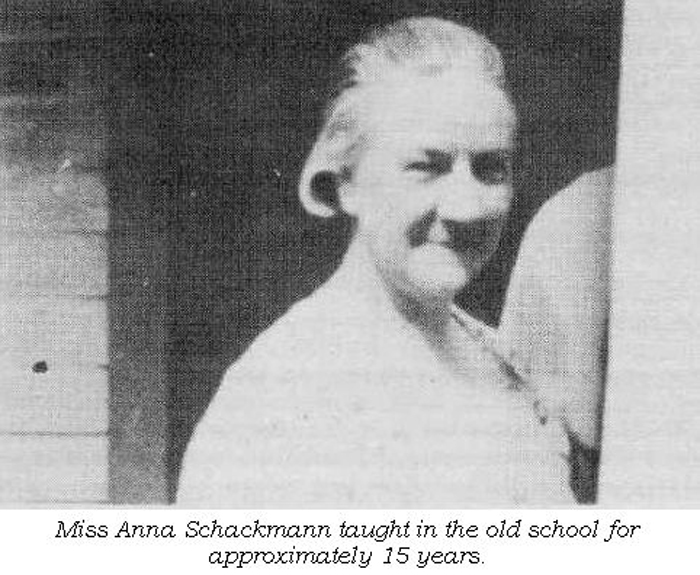
School Name: Our Lady of the Snows School School District Number: #xxx
Location: Mary's Home
Township: TwnXXN Range: RngXXW Section: SecXX
Latitude: 38.18.21 °N Longitude: -92.21.22 °W
School Information:
Date Started: 1899 Date Closed:
School Registers:
In the spring of 1889, Father Lambert Nipper, CPPS, arrived as pastor in Mary’s Home. He served the parish until 1892, when he was replaced by Father Groth, who was the first diocesan priest assigned to St. Mary’s of the Snows Parish. During Father Nippers’ stay a new frame school was built which set just forward of where the present school building sets.

First School
It was also during Father Nipper’s Time in Mary’s Home that an attempt was made to set down some guidelines for the efficient operation and maintenance of the parish and its grounds. In notes taken and signed by H.S. Tellman, Sr. at a parish meeting on January 16, 1889, it was decided that “….in case any building is done in the parish each man shall donate five days of labor each year; if he doesn’t work he shall be assessed $1.00 per day for the five days…” It was also agreed that “…each family shall give three bushels of corn a year to feed the pastor’s horses; if you have no corn, then give a load of good hay and some oats; anyone that does not have corn, hay, or oats must pay $1.50. Anyone who is so hard hearted as to do nothing for the parish shall be “ausgeschlossen” (this is a German word that means locked out, or barred from the church).
In May of 1888, Bishop J. Hogan of Kansas City administered the Sacrament of Confirmation for the first time in Mary’s Home. Awaiting the bishop’s arrival by horse and wagon, the people lined the streets of the small community in hopes of personally greeting him. At any time thereafter, when the bishop came to Mary’s Home, he was met in a similar fashion, for the people felt it was such an honor to receive him in their community.
Between the years of 1892 and 1906, there were several priests who served as pastor in Mary’s Home. These included Father Charles Puetz, Father Fred Bruch, Father Kagerbauer, and Father Joseph Kramer.
Shortly after the church was remodeled in 1906, it burned to the ground on January 1, 1907. Father Francis Kavelage, the pastor at this time, was first alerted to the fire while hunting rabbits. Enjoying his hobby on the Limbach farm, Father happened to notice remnants of burning altar lace in the air. Arriving back in town too late, Father Kavelage and his parishioners watched the church burn. It was believed the fire was caused by incense that was left burning by the altar boys.
Until a new church could be completed, services were held in the school. During 1907, the new stone church measuring 45 by 90 feet, was erected at a cost of $12,000.
The rock for the church came from the Kurtz farm, and, again, much of the labor was donated by members of the parish. The work progressed smoothly and quickly. The cornerstone for the new church was laid June 20, 1907 and was finished later that year.
Between 1938 and 1940, Father John Knoebber served as pastor of Mary’s Home. Though his time in the community was short, he is fondly remembered by his parishioners from that period. Father Knoebber was well known for his woodworking skills. He constructed the present vestment cabinets, a confessional, and a beautiful communion rail. He also taught some of his wood working skills to interested young men in the parish.
Before he left the parish, Father Knoebber made one more mark to be remembered by. Changing the name of the church from St. Marys of the Snows to Our Lady of the Snows Church, he wrote the song, “Our Lady of the Snows” which can still be heard on many Sunday mornings.
Father Walt McGrance succeeded Father Knoebber in March, 1940; however by July of the same year he was replaced by Father Cyril Goser. Father Goser served the parish until September 11, 1942, when he died of blood poisoning due to a tooth extraction.
Father Charles Bauer came to Mary’s home following the death of Father Goser. He could see the need of replacing the old frame school and he started the fund to build a new school. He was not able to see the school construction project through to its completion, for in 1948, Father Joseph Lorenz came to replace him.
It was under the direction of Father Lorenz that the new brick school was completed in 1951.

School Building - 1951
The cost of construction was $46,000, with most of the labor donated by the men of the parish. The school was rented and used by the Cole R-V School district as part of the public school system until September, 1954. It was at this time that the Sisters of St. Francis came from Nevada, Mo. to staff the school. The sisters first home was what is now the home of Tillie Schulte. This house was used as a convent until 1958, when construction began on the new convent.
Father Ferdinand Bonn was the resident pastor during the construction of the new convent. The cost of the new building was approximately $7500, with, of course, most labor being donated by the men of the parish. The men of the parish were very busy during Father Bonn’s stay. In addition to the construction of the convent, the erection of the new parish hall was begun in 1959. It was to be used during the annual parish picnic and was also to serve as a recreation center for the parish members. Some of the activities held in the hall included dances, dinners, and roller skating. In May, 1962, two bowling alleys were purchased and installed in the hall. This certainly added to the enjoyment of the hard working parishioners.
The 1960’s were a period of great change for Mary’s Home and the Catholic Church as a whole. In 1963, Father Bonn was replaced by Father Jaworski, who was replaced by Father Sean Smyth in August, 1964. In December of 1964, Father Sean celebrated the first mass in English. There was a mixed reception to this new approach, especially by some of the older parishioners who had attended the Latin mass for many years. Even today there are those who still long to hear just one more Latin mass.
In 1970, Father Smyth left Mary’s Home and was succeeded by Father Henry Reichert. It was during his stay, in 1975, that the school began to be staffed by lay teachers. Father Reichert is remembered by many for his skill in wood working, and also for his great love of the outdoors. He could always be seen mowing the lawn, caring for his roses, shoveling sidewalks, weeding the garden, or out walking his dog.
Father Riechert served the parish for seven years until 1977, when Father Don Antweiler came to take his place. Father Antweiler was with us until August, 1982, when he was succeeded by our present pastor, Father Tom Vaughn. It was Father Antweiler who initiated the planning of the Mary’s Home centennial celebration and the centennial book. Also, Father Vaughn happens to be the great grandson of Robert Morgan, one of the original settlers and merchants of this area, who was almost honored with having the town named after him.
Throughout the past one hundred years the people of Mary’s Home have been concerned with providing a good education for their young people. School in Mary’s Home was taught from 1899 until 1951 in a frame two story building which sat just forward of the present school building.
The German ancestry of the residents of Mary’s Home was reflected in the fact that German was taught in the schools and spoken in many homes until World War I.
In 1899, the mission school was staffed by Sister Christine Wierschern and Sister Casmir Garworski of the Order of the Adorers of the Blood of Christ. The sisters taught in the lower rooms of the frame school and lived in the upstairs rooms. Their records show that they had 80 children in their classrooms at that time.
The school was staffed by the Sisters of the Adorers of the Blood of Christ until 1905. When it was no longer possible to obtain nuns to staff the school, lay teachers were hired in their place. Some of the first lay teachers were Louise Krieg, Antonia and Francis Castrup, and finally Anna Schackmann from Chicago. Miss Schackmann is probably the best remembered of the teachers because she stayed approximately fifteen years, and because she was so strict she could keep control of 125 students at one time.

Anna Schackmann
At the same time that the school in town was taking shape, there were small area schools springing up in different parts of the surrounding community. These were the county schools and some of these were in operation before the town school was built. These schools were especially necessary because not all the students lived close enough to town to attend school in Mary’s Home. These one room school houses were known as Sanning School, Pleasant Ball School, Kempker School, and Jim Henry School, and several are still standing.
Children attending school around the turn of the century generally walked to school and carried their lunch with them in a paper sack or a syrup bucket. Each school had one teacher for all grades and the teacher usually walked to school also. The school structure usually consisted of one room with a wood stove in the middle. The older boys would take turns adding wood to the fire. In the winter it was often so cold that the lunches would have to be kept near the stove to keep from freezing. Although the teacher didn’t have aides, as many do today, she did not lack for extra help in the classroom. The older students in the classroom were expected to help the younger children with reading, writing, spelling, and arithmetic.
In 1924, an attempt was made to consolidate the school district; however, there were not enough votes in favor so the issue failed. During the depression years, the school became a public school supported by the state and again staffed by lay teachers. During this time the public school students would attend “vacation school” in the summer months in Mary’s Home to continue their religious education.
When the new school was built in 1951, it was used by the public school district until 1954, when the Sisters of St. Francis from Nevada, Mo. came to teach in Mary’s Home. Enrollment in the new parochial school averaged about 125 students each year. By this time the students were riding buses to school and the heating system was somewhat better than the old wood stoves used in the old school.
Some of the early memories of the parochial school include the students picking up walnuts as a source of money for the school. The highlight of each school year was the annual Christmas play. Preparations began about four weeks in advance, and under the careful direction of the sisters, skits were rehearsed, songs were learned and relearned, and costumes were prepared. About one week before the play was to be presented, the men of the parish would construct the stage in the parish hall. On the night of the Christmas play the whole parish turned out to see what the children and the sisters had prepared.
The Sister of St. Francis staffed the school until 1975, when it became necessary to hire lay teachers to take their place. Today the school is still in full operation with four lay teachers teaching grades one through eight. The school has approximately 85 students receiving the great benefits of a Catholic education.
Through the years receipts from the annual parish picnic have supported the school along with many donations of time, talent, and money from the parishioners themselves. The first indication that a parish picnic was a possibility came from notes taken at a parish meeting held on January 16, 1899. In these notes signed by Rev. L. Nipper and H.S. Tellman, Sr. it was stated that”…it was decided to pay off the debt on the school by (1) having a picnic and (2) cashing in notes and interest. “On June 9, 1924, further parish notes state that the men proposed to work out a definite plan for each parishioner to work at the picnic. Notes taken at a committee meeting on August 5, 1924, indicated that the plan had worked and that the picnic was a huge success.
School Resources